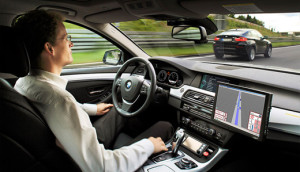 The state Senate Transportation Committee unanimously passed legislation sponsored by Senate Republican Leader Tom Kean to make New Jersey a hub for the development, testing and implementation of driverless vehicles.
The state Senate Transportation Committee unanimously passed legislation sponsored by Senate Republican Leader Tom Kean to make New Jersey a hub for the development, testing and implementation of driverless vehicles.
In June 2013, Senator Kean introduced Senate bill 734, which would make New Jersey the third U.S. state —and the first in the densely populated, fast-paced North East Region — to permit the testing of and licensing for autonomous vehicles.
“New Jersey’s workforce and economy, has a lot to gain from being at the forefront of such innovation, beyond that the overall implementation of driverless vehicles stands to make our roadways much safer and less congested,” said Kean (R-Union, Somerset, Morris).
Senator Kean noted that about 90 percent of traffic crashes are caused by human error and the implementation of driverless vehicles promises to drastically decrease traffic-related deaths and injuries. The Senator added that autonomous vehicles can also offer a more sufficient and flexible avenue of transportation for the disabled and senior citizens who may not have access to public transportation or who may not be fit to drive.
“This legislation sends a strong message to innovators and job creators that New Jersey is not afraid of being the home to new thinking and the way of the future,” Kean said. “As we heard from the testimonies of Mr. Kornhauser and Mr. Mathur today, this legislation is essential to attract and retain new jobs, innovation and entrepreneurship in New Jersey, as driverless vehicle efforts here continue to progress.”
In October, Senator Nicholas Sacco (D-Bergen, Hudson) signed on as co-prime sponsor of this legislation, which charges the state Motor Vehicle Commission with establishing standards for licensing autonomous vehicles, or any operated by artificial intelligence, sensors, GPS systems or any other self-driving technologies. The Commission would establish regulations authorizing the use of autonomous vehicles, and create rules covering safety, testing, insurance, registration and operation.
S-734 is one of the New Jersey Senate Republicans’ solutions to make New Jersey the Place to Work and Prosper, and it is the first bill to be advanced from the Senate Republican’s “Fostering Innovation” package, which was rolled out by Senator Kean at Bell Labs earlier this month.
[TLS]


As of August 28, 2014 the latest Google prototype cannot “handle heavy rain and snow-covered roads.” Functionally it can go at sluggish speeds when crossing an unmarked 4-way stop due to the algorithms of the computer taking extra precaution. There are also other limitations on discerning objects such as trash and debris that can unnecessarily veer the vehicle. Chris Urmson of Google has said that the Lidar technology cannot spot potholes or humans, such as a police officer, signaling the car to stop. The Lidar system works with on-board systems but some computation is performed on remote computer farms. So what happens if your on the GSP and the GPS in North Carolina gets wiped by a tornado?
The vehicles are unable to recognize temporary traffic signals. They have not proven themselves in snow or rain. They are also unable to navigate through parking lots. Vehicles are unable to differentiate between pedestrian and policeman or between crumpled up paper and a rock. Google projects having these issues fixed by 2020 even though the car has racked up a lot of miles, approaching a million.
Let me summarize:
1. It hasn’t been tested in heavy rain or snow (too dangerous to try)
2. It can’t read a traffic signal if the sun is behind it
3. It can’t tell the difference between a piece of crumpled paper in the road or a rock, a scarecrow or a police officer, so it will try to drive around them.
4. It can’t figure out what to do in a large parking lot or multiple-level garage. Any big lot becomes a “Target” lot.
5. Humans are just a vertical mass of pixels, so it couldn’t recognize a traffic cop giving directions.
6. Before EVERY trip, the EXACT route, and EVERY SINGLE DETAIL of the trip (like every single driveway) has to be mapped out or the car gets confused. One little deviation (like a traffic cone or trash cans) that were not on the “map” the car has memorized, and the car doesn’t know what to do.
Oh, I forgot to mention, Google’s robotic cars have about $150,000 in equipment additional to the basic price of the car itself. Fastest route to get to your ownerless house.
The Google rep claimed that all the kinks will be remedied within five or six years. 2020. Good luck with that. But no worries New Jersey’s ready.
I guess we don’t have more immediate and pressing issues to deal with? You know, like crime and corruption.
Gonna be a disaster because obviously it won’t go over the speed limit. Just imagine getting stuck behind one of these guys. Also in Lakewood it’ll never turn because there’s never a break in traffic & it’s not gonna jump into traffic.
Hey Don, again u made some really great points! We should get your top notch agents on the job before it’s to late.
Hey Anon. Anytime. We’re ready.: